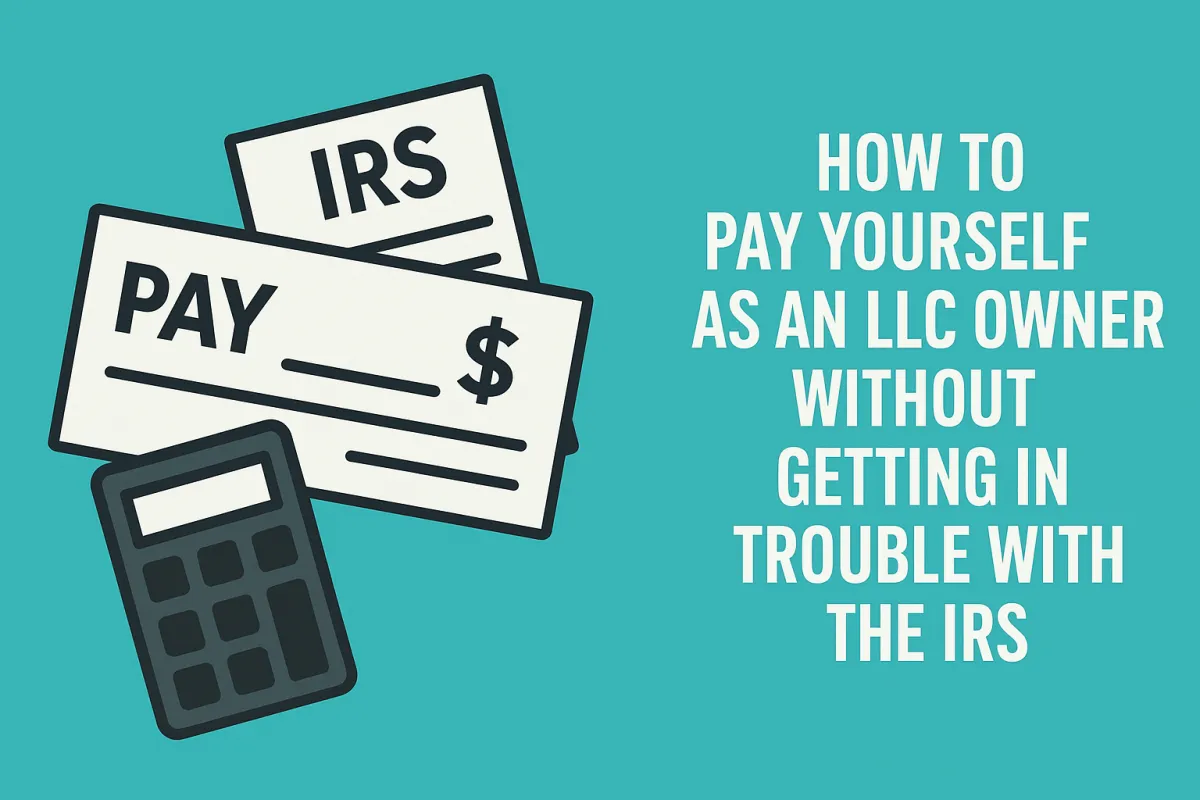
💰 How to Pay Yourself as an LLC Owner Without Getting in Trouble with the IRS
💰 How to Pay Yourself as an LLC Owner Without Getting in Trouble with the IRS
(Because “winging it” is not a payroll strategy.)
You did it. You formed your LLC. You opened the bank account. You might even have a logo that looks suspiciously professional.
And now you’re asking the million-dollar question:
“Okay… how do I pay myself?”
Because technically, you are the business — but also, you’re not the business.
Confused yet? Perfect. The IRS likes it that way.
Don’t worry — we’re going to untangle this whole “LLC owner pay” thing before you accidentally trigger an audit or start writing checks from your personal account labeled ‘CEO bonus.’

🧾 Step 1: Understand How the IRS Sees You
The first thing to know: the IRS doesn’t care what you call yourself.
You can be “Founder,” “Owner,” or “Chief Vibes Officer” — what matters is how your LLC is taxed.
You’ve got three main categories:
LLC Type How You’re Taxed How You Pay Yourself Single-Member LLC As a sole proprietor Owner’s Draw Multi-Member LLC As a partnership Owner’s Draw (split by ownership) LLC taxed as S-Corp As a corporation Salary + Distributions
Let’s break that down before your eyes glaze over.
💵 Step 2: If You’re a Single-Member LLC (Just You, Boss)
You, my friend, are what the IRS calls a disregarded entity — which sounds rude, but it just means they treat your LLC as you.
You don’t technically get a “paycheck.”
Instead, you take what’s called an owner’s draw — meaning you move money from your business bank account to your personal one.
Simple. Elegant. Legal.
💬 Pro Tip:
Keep the transfers clean — label them “Owner’s Draw” in your bookkeeping software and never mix personal spending in your business account.
The IRS hates that almost as much as it hates unreported income.
👯 Step 3: If You Have Partners (Multi-Member LLC)
Same deal as above — except now you’re splitting the pie. 🍰
Each partner gets an owner’s draw according to the ownership percentage outlined in your Operating Agreement.
At tax time, your accountant will issue each partner a K-1 form showing their share of the profits.
That’s how the IRS knows everyone’s getting their fair slice.
💬 Pro Tip:
Put your ownership percentages in writing.
Because nothing ruins a friendship faster than a “who gets what” argument during tax season.
💼 Step 4: If You’ve Elected S-Corp Status
Congratulations — you’ve just made life more complicated and potentially more profitable.
When you elect to be taxed as an S-Corp, you’re now both the owner and an employee of your business.
That means two forms of income:
A reasonable salary (the IRS loves this phrase — we’ll explain).
Owner distributions (profits after expenses and payroll).
Your salary runs through payroll, just like any other job, with taxes withheld automatically.
Your distributions come later, as owner profit — and those are not subject to self-employment tax.
💬 Translation: You save money on taxes, but you have to play by the payroll rules.
🧮 Step 5: What the Heck Is a “Reasonable Salary”?
Ah, the million-dollar IRS mystery.
A reasonable salary means what someone in your role, with your duties, would be paid by another company in the same industry.
Not too low (you can’t pay yourself $5 just to dodge taxes).
Not too high (you can’t pay yourself $200K if your business makes $60K).
💬 Pro Tip:
Look at salary data on sites like Glassdoor, PayScale, or the Bureau of Labor Statistics.
Document how you decided your salary in case the IRS ever asks — which they sometimes do.
🏦 Step 6: Keep Your Bank Accounts Separate
I know, I know — I sound like a broken record.
But this is where most LLC owners screw up.
Your business account is for business.
Your personal account is for you.
Every time you mix the two, you blur the line that protects your personal assets.
(You know, the whole “limited liability” part of your Limited Liability Company.)
💬 Pro Tip:
When in doubt, pretend your business account belongs to your strictest relative — would they approve that “business” dinner at Ruth’s Chris?
💳 Step 7: Don’t Forget About Taxes
You’re the boss now — which means you’re also your own payroll department.
If you’re a single-member or partnership LLC, you’ll pay estimated quarterly taxes on your business income.
If you’re an S-Corp, you’ll pay through payroll deductions plus corporate filings.
Either way, Uncle Sam wants his cut — early and often.
💬 Pro Tip:
Set aside 25–30% of your profits for taxes.
It hurts less to save along the way than to get walloped in April.
⚡ Step 8: When in Doubt, Get Help
If any of this made your head spin — congratulations, you’re normal.
LLC pay structures can get tricky fast, especially when your revenue grows.
A good accountant or bookkeeper is worth their weight in tax deductions.
They’ll make sure you’re paying yourself correctly, staying compliant, and maximizing your write-offs without raising red flags.
💬 Pro Tip:
Think of your accountant as your business’s personal IRS bodyguard.
🎯 Final Thought
Paying yourself as an LLC owner isn’t complicated — but it is structured.
Do it right, and you’ll:
✅ Protect your personal assets.
✅ Avoid IRS headaches.
✅ Build clean records that help you get funding later.
Do it wrong, and you’ll be starring in your own horror film called “The Audit.”
So pay yourself — proudly, consistently, and correctly.
Because you didn’t start a business to live broke, and you definitely didn’t start one to fight the IRS.
